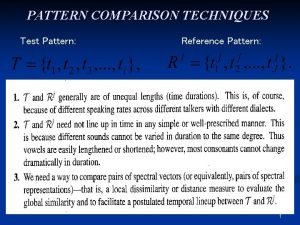Willow Pattern Willow pattern is the name given









- Slides: 9


Willow Pattern Willow pattern is the name given to the distinctive blue and white pattern found on many pieces of crockery. The style became popular in England towards the end of the 18 th century. Willow pattern is inspired by hand-painted ceramics imported from China and often depicts landscapes.

Willow Pattern The Industrial Revolution meant that for the first time it was possible to massproduce fine china. Potteries, particularly around Stoke-on-Trent in Staffordshire, produced a wide range of ceramics, and Willow pattern became so common that it is possible to find shards of blue and white pottery in almost any back garden in the UK. Next time you are gardening, keep an eye out – perhaps you will find a piece of Willow pattern pottery and will be able to share the story behind it.

Willow Pattern Plate Although inspired by Chinese imagery, the fable often associated with Willow pattern does not, in fact, originate in ancient China. The story was invented by an English potter named Thomas Minton, from Stoke-on-Trent, in order to promote the sale of his pottery.

The Fable of the Two Doves In ancient China, during the days of the Emperors, there lived a wealthy mandarin. He had a beautiful daughter, whose name was Koong-se. In the mandarin’s service was an accounting assistant named Chang. He and Koong-se were very much in love. However, as she was the daughter of a wealthy official and he was only a humble assistant, the pair were forbidden to marry. The mandarin was furious when he discovered that his daughter had fallen in love with a mere clerk. He dismissed Chang and ordered that a high fence should be built around his palace to keep the lovers apart.

The Fable of the Two Doves The mandarin then arranged a marriage between Koong-se and a powerful duke. Koong-se did not love the duke but he arrived anyway to claim his bride and brought with him a box of jewels as a gift. Unwillingly, Koong-se agreed. She and the duke were to be married on the day the first blossom fell from the willow tree.

The Fable of the Two Doves On the eve of the wedding, Chang, disguised as a servant, slipped into the palace to find his love. Koong-se was delighted and the two decided to escape with the duke’s jewels. Before they could get far, however, the alarm was raised. The mandarin, flying into a rage, chased after the young couple, whip in hand but he was not fast enough. Chang and Koong-se escaped on board the duke’s ship and fled to the safety of a secluded island.

The Fable of the Two Doves The couple, safe together, lived on that island for many happy years until one day the duke learned of their refuge. Hungry for revenge, the duke sent his solders to the island, who captured the lovers and put them to death. From high in the heavens, the gods looked down on the unhappy lovers. They were so moved that they transformed Koong-se and Chang into a pair of doves so that the pair could fly together forever.

















